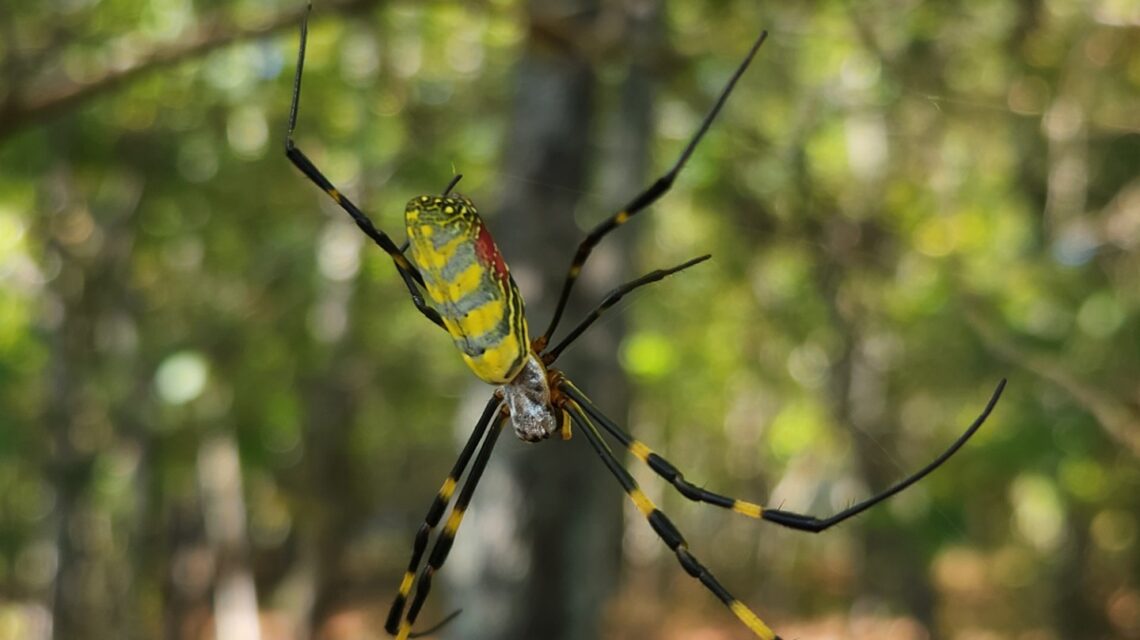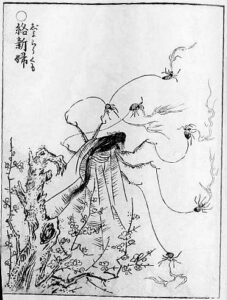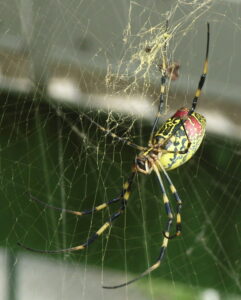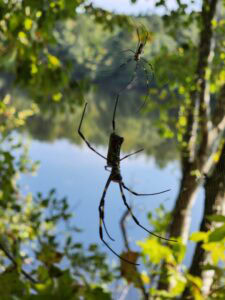What’s With All Of Those Golden Spiders?

As we near Halloween, large, golden-yellow-and-black Joro spiders have returned to hang out (literally) and provide a spook vibe. But why are there suddenly so many and do they even belong here?
You may have recently been walking down a trail in the Arabia Mountain National Heritage Area (or really any nature area in Metro Atlanta) and hiked face-first into a spider web. It was likely a yellowish web which glistened gold in the sunlight, from a Joro spider—they like to build their complex, 3-dimensional webs in wide spaces to capture insects—a nuisance, but a generally harmless (albeit potentially frightening) encounter. Joro spiders will seldom attempt to bite humans and with their tiny fangs and weak venom, bites are not dangerous regardless. However, their harm may be greater to Georgia’s ecosystem than to us.
An Uninvited Guest

A Japanese print by Toriyama Sekien of a mythical Jorōgumo, the Joro spider’s namesake.
Joro spiders, Trichonephila clavata, are not native to Georgia, the Southeast US or even North America. They originate in East Asia, including Japan, Korea, China, Taiwan and India. Their common name comes from the Jorōgumo, a mythical spider-like creature of Japanese folklore that shape-shifts into a woman. They first began appearing in the United States around 2013, with the first officially reported sighting in the Hoschton / Brasleton area, just northeast of Atlanta. In the following years they were primarily seen around northern Georgia and upstate South Carolina, but have recently been expanding their range, whether due to natural migration or further hitch-hiking with humans. But how did they get here?
Their ground zero was likely the Port of Savannah. Nonnative species often catch a ride or get caught in shipping containers and imported goods from overseas. Being one of the country’s largest ports and the Western hemisphere’s busiest single container port, Savannah’s port is known to unintentionally welcome species from abroad. More recently in 2023, the yellow-legged hornet of Asia had an appearance around Savannah after riding in through the port.
There are now established populations in Georgia and South Carolina, with increasing sightings and isolated populations in Alabama, Tennessee, Oklahoma, North Carolina, West Virginia and Maryland, with occasional sightings even farther north. While East Asia’s climate is similar to that of the Southeast US, scientists predict the further expansion of this range in the coming years as the spiders have shown to be quite resilient to colder temperatures. The Joros are good at spreading as juvenile spiders partake in “balooning,” a migration strategy in which they hold on to strands of their silk and ride wind and the Earth’s magnetic field, allowing them to expand their range.
How Has the Ecosystem Been Affected?

Insects and arachnids of all kinds are prone to being captured in the Joro’s large, wide, 3-dimensional golden web.
If you’re worried about how the Joro spider may be impacting the local environment and ecosystem, it seems to be too early for alarm. Surprisingly few studies have shown the spider to be problematic as it looks to have integrated into the South’s ecosystem. In fact some have cited benefits to the Joros introduction, such as its consumption of pests, namely the brown marmorated stink bug, another native of East Asia, which is known to damage crops. Due to this, many have been hesitant to label the Joro as “invasive” with the most common label being “nonnative” or “introduced.” (An invasive species is an introduced species that specifically and definitively causes damage to an ecosystem by messing with its natural order through outcompeting native species and damaging their populations.)
However, it may also be too early to rule out a problematic impact as some have reported discovering crucial pollinators caught in Joro webs. Pollinator numbers are already in decline due to pollution, pesticide use and the changing climate. Others report seeing fewer native spiders once Joros arrive.
What’s Next For the Joros?

A female Joro spider (bottom) and a male (top) cling to their web on a trail at Mountain Lake at Arabia Mountain.
As their introduction is still recent and their impact is still being studied, there’s currently no consensus on whether the Joro spiders should stay or if action needs be taken to control their populations. Despite this, many researchers are coming up with their own potential solutions in case the Joro numbers start getting out of control. Georgia Gwinnett College Biology Professor Dr. James Russell has been studying the effects of using Wolbachia, a bacteria, on the spiders to understand how it affects their reproduction. Evidently, the bacteria tends to render female Joros sterile when certain conditions are met. Wolbachia has been used as population control in the past against mosquitos.
As of now, the Joro spider is here to stay. The best course of action is to learn to coexist with the Joro and to allow scientists to continue to monitor the effects of its presence. Expect their return annually late summer through mid fall and remember to swipe a stick ahead of you as you hike to swab their golden webs away from your face. Or, if you’re looking for some free, spidery Halloween decorations around your house, let the Joros do their thing.